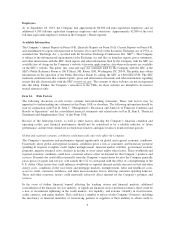Apple 2013 Annual Report Download - page 20
Download and view the complete annual report
Please find page 20 of the 2013 Apple annual report below. You can navigate through the pages in the report by either clicking on the pages listed below, or by using the keyword search tool below to find specific information within the annual report.The Company’s success depends largely on the continued service and availability of key personnel.
Much of the Company’s future success depends on the continued availability and service of key personnel,
including its Chief Executive Officer, executive team and other highly skilled employees. Experienced personnel
in the technology industry are in high demand and competition for their talents is intense, especially in Silicon
Valley, where most of the Company’s key personnel are located.
The Company’s business may be impacted by political events, war, terrorism, public health issues, natural
disasters and other circumstances.
War, terrorism, geopolitical uncertainties, public health issues, and other business interruptions have caused and
could cause damage or disruption to international commerce and the global economy, and thus could have a
material adverse effect on the Company, its suppliers, logistics providers, manufacturing vendors and customers,
including channel partners. The Company’s business operations are subject to interruption by, among others,
natural disasters, fire, power shortages, nuclear power plant accidents, terrorist attacks and other hostile acts,
labor disputes, public health issues, and other events beyond its control. Such events could decrease demand for
the Company’s products, make it difficult or impossible for the Company to make and deliver products to its
customers, including channel partners, or to receive components from its suppliers, and create delays and
inefficiencies in the Company’s supply chain. Should major public health issues, including pandemics, arise, the
Company could be adversely affected by more stringent employee travel restrictions, additional limitations in
freight services, governmental actions limiting the movement of products between regions, delays in production
ramps of new products, and disruptions in the operations of the Company’s manufacturing vendors and
component suppliers. The majority of the Company’s research and development activities, its corporate
headquarters, information technology systems, and other critical business operations, including certain
component suppliers and manufacturing vendors, are in locations that could be affected by natural disasters. In
the event of a natural disaster, the Company could incur significant losses, require substantial recovery time and
experience significant expenditures in order to resume operations.
The Company expects its quarterly revenue and operating results to fluctuate.
The Company’s profit margins vary across its products and distribution channels. The Company’s software,
accessories, and service and support contracts generally have higher gross margins than certain of the Company’s
other products. Gross margins on the Company’s hardware products vary across product lines and can change
over time as a result of product transitions, pricing and configuration changes, and component, warranty, and
other cost fluctuations. The Company’s direct sales generally have higher associated gross margins than its
indirect sales through its channel partners. In addition, the Company’s gross margin and operating margin
percentages, as well as overall profitability, may be materially adversely impacted as a result of a shift in
product, geographic or channel mix, component cost increases, the strengthening U.S. dollar, price competition,
or the introduction of new products, including those that have higher cost structures with flat or reduced pricing.
The Company has typically experienced higher net sales in its first quarter compared to other quarters due in part
to seasonal holiday demand. Additionally, new product introductions can significantly impact net sales, product
costs and operating expenses. The Company could be subject to unexpected developments late in a quarter, such
as lower-than-anticipated demand for the Company’s products, issues with new product introductions, an internal
systems failure, or failure of one of the Company’s logistics, components supply, or manufacturing partners.
The Company’s stock price is subject to volatility.
The Company’s stock continues to experience substantial price volatility. Additionally, the Company, the
technology industry, and the stock market as a whole have experienced extreme stock price and volume
fluctuations that have affected stock prices in ways that may have been unrelated to these companies’ operating
performance. Price volatility over a given period may cause the average price at which the Company repurchases
its own stock to exceed the stock’s price at a given point in time. The Company believes its stock price reflects
18
























